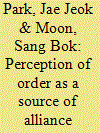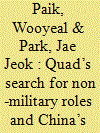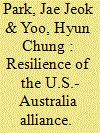|
|
|
Sort Order |
|
|
|
Items / Page
|
|
|
|
|
|
|
| Srl | Item |
| 1 |
ID:
119079


|
|
|
|
|
| Publication |
2013.
|
| Summary/Abstract |
The US-Republic of Korea (ROK) alliance had significantly developed asset specificities and common social identities attached to it during the cold war period. If institutional features and ideational factors originating from the cold war threat can account for alliance resilience in the post-cold war period, the US-ROK alliance should be a 'most likely case' to support those causal links. This article shows that such is not the case. This article, instead, argues that the US-ROK alliance went beyond being an instrument of threat response to becoming a more complicated mechanism for serving 'general interests' in relation to North-East Asian regional order maintenance and order-building, which drove the US-ROK alliance between 1998 and 2008.
|
|
|
|
|
|
|
|
|
|
|
|
|
|
|
|
| 2 |
ID:
154931


|
|
|
|
|
| Summary/Abstract |
Whatever motivations lie behind North Korea’s nuclear and missile programs, North
Korea has been aware that further nuclear and missile tests would incur increasingly
harsh international sanctions. In order to survive the sanctions, North Korea needs
to entrap China to its side, for the North Korean economy is highly dependent upon
China. In this context, this article argues that North Korea intentionally increases
the level of its nuclear and missile threat in order to entrap China (thus, reducing its
fear of being abandoned by China). That is, North Korea has elaborated its coercive
diplomacy in order to press China to show a strong commitment to their mutual
alliance. In order to develop the above argument, this article proceeds as follows.
First, as an analytical framework, it applies Glenn Snyder’s concept of the linkage
between the alliance game and adversary game to the trilateral relationship among
the United States (along with South Korea), China and North Korea. Second, it
provides an overview of Sino–North Korean relations from 2006 up to the present,
attempting to analyze North Korea’s brinkmanship. Thirdly, it concludes with some
policy implications for future trilateral relations, one of which is that China should
seriously discuss North Korea contingency plans with the United States and South
Korea in order to develop an effective strategy to curb North Korea’s military
adventurism. Paradoxically, this would lead to North Korea’s fully considering
China’s position.
|
|
|
|
|
|
|
|
|
|
|
|
|
|
|
|
| 3 |
ID:
131880


|
|
|
|
|
| Publication |
2014.
|
| Summary/Abstract |
The level of alliance cohesion is affected by the shift of attitudinal aspects (such as homogeneity in goals and threat perceptions) and behavioural aspects (such as strategic compatibility, command structure and defence burden-sharing) of alliance operation. In particular, a clear threat perception tends to make an alliance cohesive, as it suppresses (potential) disputes over the behavioural aspects of alliance operation. This article argues, however, that it is not sufficient to evaluate whether an alliance is cohesive or not only by looking at how these attitudinal and behavioural indicators have changed over time. If it were sufficient to do so, it would be supposed that the level of alliance cohesion would be bound to become lower with a change of government from conservative political forces to liberal ones in cases such as those of the US-ROK and the US-Japan alliances. We argue that the list of indicators for alliance cohesion should include not only attitudinal and behavioural aspects of alliance operation, but also functional aspects. While serving its primary purpose of responding to a specific threat, an alliance incurs an additional function of serving to maintain or to build a favourable regional order that is appreciated by both liberal and conservative governments. The interests in relation to order-building and order-maintenance motivate allies to invest for the alliance, often at their own political risk, even while they are engaged in contentious negotiations with the United States over attitudinal and behavioural aspects of alliance operations. Such investments can be considered as a different type of alliance burden sharing than has heretofore been given adequate attention. The investments indeed consolidate the alliance, paving the way for further upgrading of the alliance as conditions warrant.
|
|
|
|
|
|
|
|
|
|
|
|
|
|
|
|
| 4 |
ID:
123003


|
|
|
|
|
| Publication |
2013.
|
| Summary/Abstract |
Alliance persistence in the face of the disappearance of mutual threat or the deterioration of mutual threat perceptions between allies comprises the major concern of this article. This article argues that an alliance (whose primary threat-centric rationale has significantly diminished, if not disappeared) persists if two conditions are met: (i) the alliance serves as an essential arrangement for pursuing an 'order insurance strategy' (which is termed in this article as 'alliance for order insurance') and (ii) the allies invest for such benefits with arrangements to ensure alliance preservation against challenges that arise as a result of alliance mismanagement (which is termed in this article as 'insurance for alliance'). To test this argument, this article evaluates the persistence of the United States-Australia alliance in the post-Cold War period. Also, to achieve some basis for falsification, it explores the discontinuation of the United States-New Zealand leg of ANZUS since the mid-1980s and the United States-Philippines alliance during most of the 1990s.
|
|
|
|
|
|
|
|
|
|
|
|
|
|
|
|
| 5 |
ID:
178697


|
|
|
|
|
| Summary/Abstract |
The Quadrilateral Security Dialogue (‘Quad’)—a cooperative consisting of the US, Japan, Australia, and India—has re-emerged since 2017 after a decade of dormancy. After typologizing the minilateral security cooperation’s goals and its expansion, this article explains that the current Quad is an expanded minilateral cooperation of the existing various security bilaterals and trilaterals among its member states. This minilateral has increased its non-military cooperation, focusing on infrastructure-building to counter that of China’s Belt and Road Initiative in the Indo-Pacific region. It also examines how China has been responding to this line of the Quad’s economic responses, while China is cautious about the Quad’s security implications. It concludes with some predictions as to how this set of interactions is likely to influence the regional order.
|
|
|
|
|
|
|
|
|
|
|
|
|
|
|
|
| 6 |
ID:
142085


|
|
|
|
|
| Summary/Abstract |
Despite potentially significant differences between an American superpower’s and an Australian middle power’s global and regional interests and strategies, the U.S.- Australia alliance has remained resilient. Moreover, Australia has recently been very cooperative with the U.S. deployment of its military assets on Australian soil. What lies behind this intriguing set of circumstances in alliance relations? To address this question, this article begins by providing a historical overview to show that the U.S.- Australia alliance is resilient despite the lack of a mutually perceived threat. Then, this article criticizes the argument that the U.S.-Australia alliance continues because it is insurance against potential military threats, especially against potential Chinese threats. First, the likelihood of a “fundamental” attack on the Australian homeland is very slim. Moreover, the ANZUS accord lacks a formal mechanism that triggers an automatic U.S. involvement in the way that NATO’s Article Five mandates such a U.S. response in Europe. Second, currently the American and Australian threat perceptions regarding China vary. Canberra entertains less fear of a “rising China” than does Washington. Instead, this article provides order-centric rationales for retaining and strengthening the U.S.-Australia alliance, and in that context it analyzes the recent development of the alliance’s military aspects, including the deployment of U.S. Marines in Darwin on a rotational basis.
|
|
|
|
|
|
|
|
|
|
|
|
|
|
|
|
| 7 |
ID:
106015


|
|
|
|
|
| Publication |
2011.
|
| Summary/Abstract |
The 'hub-and-spoke' alliance structure led by the United States was - and remains - a major feature of security politics in the Asia-Pacific. This article links its 'general interests' with the larger issue of the Asia-Pacific's evolving multilateral regional order. After reviewing the concept of 'hedging', the first section problematises the literature that treats the US-led alliances which constitute the hub-and-spoke system mainly as instruments for the competitive side of a hedging strategy. The second section observes that they go beyond being instruments of threat response to becoming a more complicated network of regional multilateral order-maintenance and order-building. The third section claims that the United States and its regional allies have been utilising the hub-and-spoke alliance structure as a hedge against an undesirable multilateral order emerging in the region. The fourth section examines those arguments with reference to the East Asia Summit (EAS) and the Six Party Talks. The article concludes with some thoughts about what these findings mean for the future direction of the hub-and-spoke alliance structure in the Asia-Pacific.
|
|
|
|
|
|
|
|
|
|
|
|
|
|
|
|
| 8 |
ID:
190666


|
|
|
|
|
| Summary/Abstract |
The liberal security order in the Indo-Pacific led by the US has been transitioning to one managed by a US-led security network. As a result, the geostrategic competition between the US and China has also been transforming to one between this US-led network and China. In the process, Japan, Australia, and India have emerged as major ‘nodes’ of the network. In this context, this paper adopts the concept of ‘network power’ to claim that South Korea—while it still favors being a part of the network—is concerned that it would be relegated to the status of a small peripheral node mainly ‘tied’ to Japan, the regional hub of the network in Northeast Asia. To mitigate this concern, South Korea attempts to avoid unnecessarily seeming to exclude China while still favoring the network; aligns with other regional nodes in the network, whether Australia, India, or some ASEAN states; and increasingly frames its role as that of an active ‘order-shaper’ rather than a passive ‘order-taker’.
|
|
|
|
|
|
|
|
|
|
|
|
|
|
|
|
|
|
|
|
|